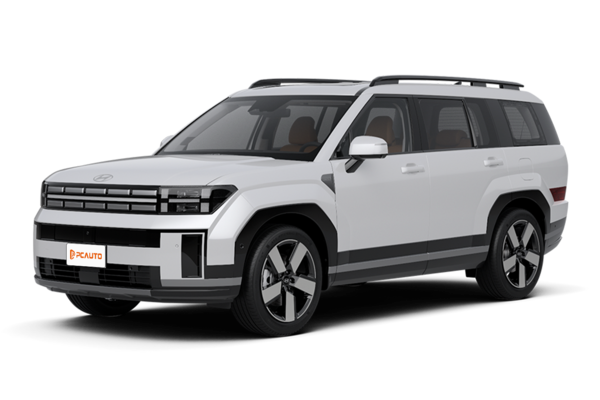Q
Is the 2019 Santa Fe reliable?
The 2019 Santa Fe delivers solid reliability overall. Its 2.4L and 2.0T engines are proven units, paired with either smooth-shifting 6-speed or 8-speed automatic transmissions that show low failure rates. Maintenance costs are reasonable for the segment.
You'll appreciate the spacious cabin and generous equipment, especially the safety tech like forward collision warning and lane keeping assist – these really boost confidence behind the wheel. That said, a few owners report occasional infotainment system glitches, so it's worth checking for software updates before purchase.
As a family SUV, the Santa Fe's durability sits above average in its class. Stick to the maintenance schedule and drive it right, and it'll serve you well for years. For used models, always review the full service history and pay extra attention to the undercarriage and electronics – these tell you more about the car's real condition than anything else.
Hyundai's build quality has come a long way, and this Santa Fe proves it. For practical buyers who want bang for their buck, it's a trustworthy choice.
Special Disclaimer: This content is published by users and does not represent the views or position of PCauto.
Related Q&A
Q
What is the safety rating of the 2019 Hyundai Santa Fe?
The 2019 Hyundai Santa Fe delivers outstanding safety performance, earning top marks from leading evaluation agencies. It secured the IIHS "Top Safety Pick+" rating in the U.S. and a five-star Euro NCAP score in Europe—thanks to its rigid body structure, comprehensive active safety features, and advanced driver-assistance systems.
Standard equipment includes forward collision warning, automatic emergency braking, lane-keeping assist, and blind-spot monitoring. Higher trims add adaptive cruise control and rear cross-traffic alert for even greater protection.
Family-focused buyers can trust the Santa Fe’s safety credentials. Its high-strength steel construction effectively absorbs and disperses crash energy, while multiple airbags provide added security.
If you’re considering a used Santa Fe, don’t just rely on its safety ratings—check maintenance records and accident history to ensure all safety systems function properly. Even the best safety tech needs regular upkeep to perform at its best.
Q
Is the 2019 Hyundai Santa Fe all wheel drive?
The 2019 Hyundai Santa Fe does offer an all-wheel drive (AWD) variant, equipped with the HTRAC intelligent AWD system. This setup automatically distributes torque between the front and rear wheels based on road conditions, improving traction and stability on slippery surfaces or light off-road terrain.
In local markets, higher trim levels often come standard with AWD, while entry-level models may default to front-wheel drive—always check the vehicle's badge or spec sheet to confirm. Beyond handling wet weather with confidence, this AWD tech enhances safety on winding mountain roads. Hyundai's system uses electronic controls to seamlessly adjust power distribution between axles, balancing performance with fuel efficiency.
Keep in mind: AWD differs from traditional 4WD (built for rugged off-roading), as it prioritizes on-road agility. Buyers should weigh their typical driving needs. The Santa Fe's AWD also features selectable drive modes (Eco, Comfort, Sport) to adapt to different conditions.
Q
What is the recall on the 2019 Hyundai Santa Fe?
The 2019 Hyundai Santa Fe recall primarily addresses two critical issues. First, certain vehicles may have a software glitch in the anti-lock braking system (ABS) module, which could potentially increase stopping distances under specific conditions, raising collision risks. Hyundai is resolving this by rolling out a control module software update.
Second, some models may contain a hydraulic electronic control unit (HECU) with manufacturing defects that could lead to electrical shorts, posing a fire hazard. Dealers will inspect and replace affected components at no cost.
Recalls like these are proactive safety measures initiated by automakers. Owners can check their vehicle’s recall status by entering the VIN on Hyundai’s official website. Keep in mind, all car brands occasionally issue recalls due to supply chain issues or the complexity of modern electronics—it’s actually a sign of responsible manufacturing.
We recommend staying updated with brand service bulletins and completing recall repairs promptly. Most software updates or part replacements take just 30 minutes to 2 hours and won’t void your warranty. If you notice abnormal brake warning lights or a burning smell, contact an authorized service center immediately.
Q
Is the 2019 Santa Fe a reliable car?
The 2019 Santa Fe delivers decent reliability for a midsize SUV. Its proven 2.4L four-cylinder and 2.0L turbocharged engines provide smooth power delivery, while the transmission pairing is well-sorted. Major mechanical issues are uncommon in daily driving.
Owners report the suspension is tuned for comfort, making it family-friendly, and the interior materials/fit-and-finish are competitive for the segment. That said, some owners note occasional minor glitches with electronics—like infotainment screen lag—though these rarely affect drivability.
If buying used, always check the vehicle history or opt for units with complete maintenance records. Hyundai's quality has improved noticeably in recent years, and as their flagship SUV, the Santa Fe remains a generally dependable choice. Just remember—consistent maintenance and proper care go a long way in keeping it trouble-free.
Q
Is there any recalls on the 2019 Hyundai Santa Fe?
The 2019 Hyundai Santa Fe was subject to recall notices in certain markets due to potential safety concerns. These included possible short circuits in the brake system's hydraulic electronic control unit, which could reduce braking force, as well as necessary software updates for the anti-lock braking system (ABS) in some vehicles.
Owners are advised to check their vehicle's recall status using the VIN on Hyundai’s official website or through an authorized service center to ensure their vehicle meets the latest safety standards. As a good practice, regularly test your brake response and ABS functionality. If you notice a stiff brake pedal or warning lights, have it inspected immediately.
Hyundai operates a global recall system, with all repairs handled free of charge at authorized service points—just book an appointment. For used car buyers, verifying whether previous owners completed all recall fixes should be part of the pre-purchase checks.
Q
Does the 2019 Santa Fe have 3 rows?
The 2019 Santa Fe offers an optional third-row seating configuration in select markets, making it a seven-seater for family-oriented buyers. However, availability depends on trim levels and regional specifications—higher trims are more likely to include this feature.
As a midsize SUV, it prioritizes practicality, though the third row is best suited for children or occasional adult use on shorter trips. For extended journeys, adults may find it somewhat cramped. Competing models like the Toyota Fortuner or Honda CR-V also offer similar three-row layouts in this segment.
If you're considering the seven-seat version, we recommend test-driving to evaluate the third-row space firsthand. Also, keep in mind that additional seating may affect vehicle inspections and insurance policies. For frequent group travel, an MPV might be a better choice, as they typically provide more generous third-row accommodations.
Before purchasing, always verify the seating configuration with the dealer or check the spec sheet, as mid-cycle updates can sometimes alter available options.
Q
Does the 2019 Santa Fe have a sunroof?
Certain higher-trim 2019 Santa Fe models did come equipped with a panoramic sunroof, which significantly enhances cabin brightness and overall comfort. However, availability depends on the specific trim level purchased, as features vary across the range.
For sunroof maintenance, make sure to regularly clean the tracks and check that drainage holes are clear. Avoid prolonged sun exposure to prevent rubber seal deterioration—these simple steps can extend its lifespan. If you're considering a used Santa Fe, pay close attention to the sunroof's operation and check for any signs of water leakage, as these details often reveal how well the vehicle's been maintained.
While the sunroof does add to the enjoyment on road trips, drivers in hotter climates may find themselves using the sunshade more frequently to keep the cabin comfortable.
Q
What engine options did the 2019 Santa Fe offer?
The 2019 Santa Fe offers two engine options to suit different driving needs.
First up is the 2.4L naturally aspirated four-cylinder, delivering a solid 185 horsepower and 178 lb-ft of torque. It’s a great fit for daily city driving, with balanced fuel efficiency and smooth power delivery.
If you’re after more punch, the 2.0L turbocharged four-cylinder steps it up with 235 horsepower and 260 lb-ft of torque—perfect for drivers who want extra power for highway passing or loaded-up trips. Both engines pair with an 8-speed automatic transmission for seamless shifts.
As a midsize SUV, the Santa Fe strikes a nice balance between efficiency and performance. It also packs Hyundai’s latest safety tech at the time, like forward collision warning and lane-keeping assist, to help keep things secure on the road.
Quick note on the turbo: By forcing more air into the combustion chamber, it squeezes out extra power from the same displacement. Just remember—regular maintenance is key to keeping that turbo running smoothly for the long haul.
Q
Is the 2019 Hyundai Santa Fe AWD?
The 2019 Hyundai Santa Fe does offer an AWD variant, equipped with the HTRAC intelligent all-wheel-drive system. This SUV automatically distributes power between the front and rear axles based on road conditions, delivering better traction on slippery surfaces or during light off-roading. In local markets, both the high-spec 2.2L diesel and 2.4L gasoline models come with this system.
The AWD version features a drive mode selector on the center console, allowing you to switch between Eco/Comfort/Sport/Smart modes. In Smart mode, it adjusts power distribution dynamically by analyzing throttle input, steering angle, and other data. That said, this system is primarily designed for urban driving and light unpaved terrain—it’s not a hardcore off-road setup.
Competing Japanese models like the Honda CR-V and Toyota RAV4 use a similar clutch-based on-demand AWD, while German rivals often favor full-time AWD solutions. For buyers, the choice depends on usage: if you frequently encounter rainy conditions or occasional muddy job sites, the AWD version is more practical. But if you’re mostly driving in the city, the FWD model offers better fuel efficiency (saving around 5-8% in consumption) and value.
Q
How many miles will a 2019 Santa Fe last?
The 2019 Santa Fe can typically last between 200,000 to 300,000 kilometers or more with proper maintenance—actual mileage depends on driving habits, road conditions, and service frequency. Its proven 2.4L or 2.0T engine options, paired with a 6-speed or 8-speed automatic transmission, deliver solid reliability. Staying on top of oil changes, transmission fluid, and filter replacements goes a long way in extending its lifespan.
The body structure uses high-strength steel with decent corrosion resistance, making it a good fit for our rainy climate. Still, it’s wise to get the underbody and suspension checked periodically for rust. For mixed driving conditions, a full service every 10,000 km is recommended. If you’re mostly doing short city trips, keep an eye out for carbon buildup.
Hyundai’s electronics have gotten more stable in recent years, but occasional software updates don’t hurt. Repair costs are reasonable for the segment, OEM parts are easy to find, and resale value is mid-pack. If you plan to keep it long-term, maintain complete service records—it’ll help with both performance and resale value down the road.
Latest Q&A
Q
Does the 2025 Volvo XC90 have wireless charging?
The 2025 Volvo XC90 does come equipped with wireless charging, seamlessly integrated into the front center console storage area. Supporting the Qi standard, it’s compatible with most mainstream smartphones, allowing both drivers and passengers to top up their devices without fumbling with cables on the go.
Beyond wireless charging, the model continues Volvo’s tech-forward approach, featuring standard 12.3-inch digital instrument clusters and a 9-inch portrait-style touchscreen, powered by the Android-based Sensus infotainment system. Wireless Apple CarPlay and Android Auto come baked in for effortless connectivity.
That said, wireless charging availability may vary by trim or optional packages, so it’s worth double-checking the specs with your dealer before committing.
On the electrification front, Volvo’s been pushing hard, and the XC90—as the brand’s flagship SUV—showcases that ambition. The plug-in hybrid T8 Recharge variant steps it up with a larger battery pack and refined power distribution, underscoring Volvo’s dual focus on smart tech and sustainable driving.
Q
What is the range of the Volvo XC90 2025 hybrid?
The 2025 Volvo XC90 plug-in hybrid is expected to deliver an all-electric range of approximately 50 to 60 kilometers, though actual figures may vary slightly depending on driving conditions and battery configuration. Staying true to Volvo’s commitment to safety and sustainability, this model features an efficient hybrid system with excellent combined fuel efficiency, making it ideal for both daily commutes and long-distance trips.
The plug-in hybrid technology significantly reduces fuel consumption while delivering smoother driving dynamics. Volvo’s hybrid system has been refined over years, offering proven reliability, stable battery performance, and increasingly convenient charging options—many public stations now support fast charging.
If you prioritize longer electric range, the all-electric version might be worth considering. However, the plug-in hybrid holds an advantage in fuel flexibility, especially in regions where charging infrastructure is still developing. Volvo remains focused on sustainability, and future updates may further enhance battery technology to extend electric range. For the latest and most accurate details, keep an eye on official announcements.
Q
How much horsepower does a 2025 XC90 have?
The detailed powertrain specs for the 2025 Volvo XC90 haven’t been fully revealed yet, but judging by the current model and the brand’s tech direction, it’ll likely stick with efficient setups. The current XC90 T8 plug-in hybrid delivers a combined 390 hp, pairing a 2.0L turbocharged engine with an electric motor, while the B6 mild hybrid pushes around 300 hp. The new version could feature upgraded hybrid systems with improved battery capacity for longer electric-only range.
Volvo’s been all-in on electrification lately—their Drive-E engines are known for modular designs that balance performance and eco-friendliness, and the plug-in hybrids even support fast charging. That said, horsepower isn’t the whole story. Torque, transmission tuning, and the standard all-wheel-drive system all shape the driving experience. Plus, the XC90’s suite of active safety tech (like City Safety) adds everyday practicality. Keep an eye on official updates for the final numbers.
Q
What is the cost of a 2025 Volvo XC90?
The official pricing for the 2025 Volvo XC90 hasn’t been announced yet, but based on the current model’s price range and potential upgrades, we expect the starting price to land between RM 400,000 and RM 500,000. Final figures will vary depending on trim levels and powertrain options.
The new XC90 is likely to feature a more advanced plug-in hybrid system and the latest safety tech, including an upgraded Pilot Assist semi-autonomous driving system and a smarter infotainment setup. As always, Volvo emphasizes safety and sustainability—expect the flagship SUV to deliver top-notch interior craftsmanship with eco-friendly materials, plus plenty of luxury add-ons.
If you’re considering this model, keep an eye on official updates or reach out to dealers for exact pricing and test drives. It’s also worth cross-shopping rival luxury SUVs to weigh your options before deciding.
Q
Is the 2025 Volvo XC90 a good car?
The 2025 Volvo XC90 stands out as a well-rounded luxury SUV, blending Scandinavian design, cutting-edge tech, and class-leading safety into a compelling package.
Retaining the brand’s minimalist styling, the cabin features premium sustainable materials and an upgraded Sensus infotainment system with wireless Apple CarPlay/Android Auto—now noticeably smoother to use. Powertrain options include a plug-in hybrid variant that balances performance and efficiency, offering improved electric-only range.
Safety remains its trump card: the standard City Safety suite now adds more driver aids like blind-spot monitoring and rear cross-traffic alert. Space is another strong suit, with a versatile three-row layout ideal for families. Compared to German rivals, the XC90 delivers better value, especially with its more generous standard safety gear.
Backed by a widespread service network, reasonable maintenance intervals, and reliable parts supply, this is a top pick for safety-conscious, eco-aware buyers—particularly families or those who regularly tackle long trips with a full load.
View MoreRelated News

In Malaysia, which sliding door MPVs are available?
MichaelOct 30, 2025

Modern Ioniq 5 N Lands in Malaysia: Track-Level Performance Electric Vehicle is Here, Priced Possibly Below RM 400,000?
JohnSep 10, 2025

Hyundai's Big Return to Malaysia: Top 5 Models Expected
MichaelMay 30, 2025

580,000 km & 87.7% Battery Health: Ioniq 5’s Incredible Durability
MichaelMay 6, 2025

Revolutionizing Hybrids: Hyundai’s New System vs. Toyota's Hybrid System
Kevin WongApr 22, 2025
View More















Pros
Cons